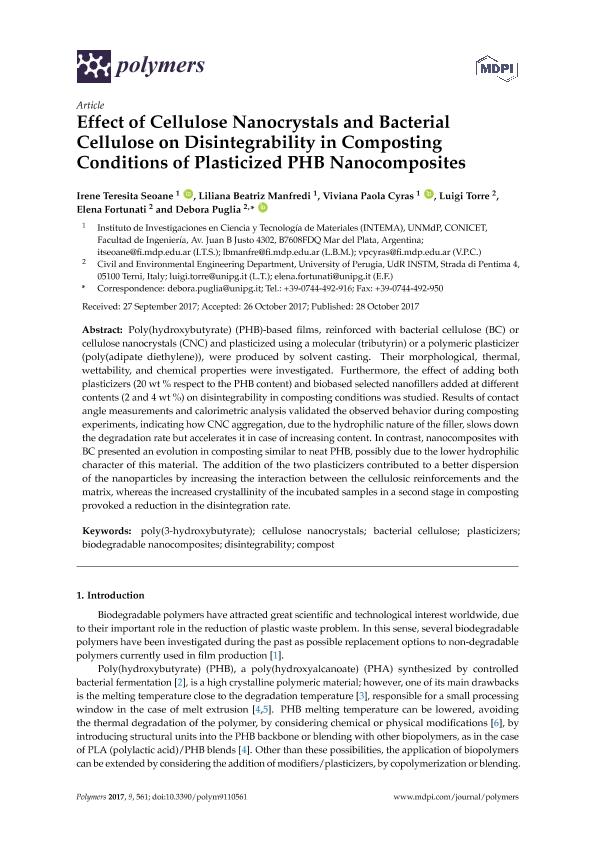Artículo
Effect of cellulose nanocrystals and bacterial cellulose on disintegrability in composting conditions of plasticized PHB nanocomposites
Seoane, Irene Teresita ; Manfredi, Liliana Beatriz
; Manfredi, Liliana Beatriz ; Cyras, Viviana Paola
; Cyras, Viviana Paola ; Torre, Luigi; Fortunati, Elena; Puglia, Debora
; Torre, Luigi; Fortunati, Elena; Puglia, Debora
 ; Manfredi, Liliana Beatriz
; Manfredi, Liliana Beatriz ; Cyras, Viviana Paola
; Cyras, Viviana Paola ; Torre, Luigi; Fortunati, Elena; Puglia, Debora
; Torre, Luigi; Fortunati, Elena; Puglia, Debora
Fecha de publicación:
28/10/2017
Editorial:
MDPI
Revista:
Polymers
ISSN:
2073-4360
Idioma:
Inglés
Tipo de recurso:
Artículo publicado
Clasificación temática:
Resumen
Poly(hydroxybutyrate) (PHB)-based films, reinforced with bacterial cellulose (BC) or cellulose nanocrystals (CNC) and plasticized using a molecular (tributyrin) or a polymeric plasticizer (poly(adipate diethylene)), were produced by solvent casting. Their morphological, thermal, wettability, and chemical properties were investigated. Furthermore, the effect of adding both plasticizers (20 wt % respect to the PHB content) and biobased selected nanofillers added at different contents (2 and 4 wt %) on disintegrability in composting conditions was studied. Results of contact angle measurements and calorimetric analysis validated the observed behavior during composting experiments, indicating how CNC aggregation, due to the hydrophilic nature of the filler, slows down the degradation rate but accelerates it in case of increasing content. In contrast, nanocomposites with BC presented an evolution in composting similar to neat PHB, possibly due to the lower hydrophilic character of this material. The addition of the two plasticizers contributed to a better dispersion of the nanoparticles by increasing the interaction between the cellulosic reinforcements and the matrix, whereas the increased crystallinity of the incubated samples in a second stage in composting provoked a reduction in the disintegration rate.
Archivos asociados
Licencia
Identificadores
Colecciones
Articulos(INTEMA)
Articulos de INST.DE INV.EN CIENCIA Y TECNOL.MATERIALES (I)
Articulos de INST.DE INV.EN CIENCIA Y TECNOL.MATERIALES (I)
Citación
Puglia, Debora; Fortunati, Elena; Torre, Luigi; Manfredi, Liliana Beatriz; Cyras, Viviana Paola; Seoane, Irene Teresita; et al.; Effect of cellulose nanocrystals and bacterial cellulose on disintegrability in composting conditions of plasticized PHB nanocomposites; MDPI; Polymers; 9; 11; 28-10-2017; 561
Compartir
Altmétricas



